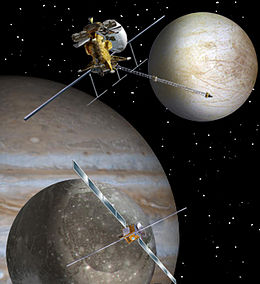Europa Jupiter System Mission – Laplace
 Artist concept of the Europa Jupiter System Mission: Jupiter Europa Orbiter (top) and Jupiter Ganymede Orbiter (bottom). | |
| Mission type | Multiple orbiters and lander |
|---|---|
| Operator | Proposed joint NASA / ESA |
The Europa Jupiter System Mission – Laplace (EJSM-Laplace) was a proposed joint NASA/ESA uncrewed space mission slated to launch around 2020 for the in-depth exploration of Jupiter's moons with a focus on Europa, Ganymede and Jupiter's magnetosphere. The mission would have comprised at least two independent elements, NASA's Jupiter Europa Orbiter (JEO) and ESA's Jupiter Ganymede Orbiter (JGO), to perform coordinated studies of the Jovian system.
The Japan Aerospace Exploration Agency (JAXA) and the Roscosmos (Russian Space Agency) had expressed their interest in contributing to EJSM-Laplace, although no deals had been finalized. JEO was estimated to cost US$4.7 billion,[1] while ESA would spend US$1.0 billion (€710 million) on JGO.[2]
In April 2011, European Space Agency (ESA) stated that it seemed unlikely that a joint US–European mission will happen in the early 2020s given NASA's budget, so ESA continued with its initiative, called the Jupiter Icy Moons Explorer (JUICE) that will be based on the JGO design. Selection of JUICE for the L1 launch slot of ESA's Cosmic Vision science programme was announced on 2 May 2012.[3]
Later, in June 2015, NASA approved the Europa Clipper and it entered the formulation stage,[4] with an expected launch between 2022-2025.
Origins[]
In February 2008, NASA and ESA began joint investigations into sending a probe to study the icy satellites of the outer Solar System under the title Outer Planet Flagship Mission.[5] Two primary candidate missions were considered under the study: EJSM and Titan Saturn System Mission (TSSM), also known under the ESA designation TandEM.
In February 2009, it was announced that NASA/ESA had given EJSM priority ahead of the TSSM.[6][7] The ESA contribution still faced funding competition from two other missions, the Laser Interferometer Space Antenna (LISA) and the International X-ray Observatory (IXO), which is why NASA kept a contingency plan of sending its part of the mission as a stand-alone project.[8]
Mission architecture[]

The most distinctive feature of the EJSM/Laplace-study, was the proposed collaboration with multiple orbiters and landers:
 NASA: Jupiter Europa Orbiter (JEO), proposed to study Europa and Io.
NASA: Jupiter Europa Orbiter (JEO), proposed to study Europa and Io. ESA: Jupiter Ganymede Orbiter (JGO), proposed to study Ganymede and Callisto
ESA: Jupiter Ganymede Orbiter (JGO), proposed to study Ganymede and Callisto JAXA: Jupiter Magnetospheric Orbiter (JMO), proposed to study Jupiter's magnetosphere.
JAXA: Jupiter Magnetospheric Orbiter (JMO), proposed to study Jupiter's magnetosphere. JAXA: Jupiter and Trojan Asteroid Explorer (JTAX), proposed to study a Jupiter trojan.
JAXA: Jupiter and Trojan Asteroid Explorer (JTAX), proposed to study a Jupiter trojan.
The baseline EJSM architecture consisted of JEO and JGO, which were proposed to be launched in 2020 and explore the Jupiter System before settling into orbit around Europa and Ganymede, respectively. The JEO and JGO were separate and independent spacecraft developed, launched and operated by their respective organizations to work together. Their launch dates and interplanetary trajectories were not to be dependent on each other, but would have been synergistic.[9]
Goal[]
The goal was to determine whether the Jupiter system harbors habitable environments, while focusing on Europa and Ganymede. The main science objectives supporting this goal were:[9]
- Characterize sub-surface oceans
- Characterize the ice shells and any subsurface water
- Characterize the deep internal structure for Ganymede and the intrinsic magnetic field
- Compare the exospheres, plasma environments, and magnetospheric interactions.
- Determine global surface compositions and chemistry
- Understand the formation of surface features, including sites of recent or current activity, and identify and characterize candidate sites for future in situ exploration.
References[]
- ^ Vision and Voyages for Planetary Science in the Decade 2013–2022 (2011) (page 365)
- ^ de Selding, Peter B. (4 February 2011). "Europe's Next Big Mission Depends on U.S. and Japan". Space News. Retrieved 22 May 2011.
- ^ Amos, Jonathan (2 May 2012). "Esa selects 1bn-euro Juice probe to Jupiter". BBC News Online. Retrieved 2 May 2012.
- ^ Howell, Elizabeth (20 June 2015). "NASA's Europa Mission Approved for Next Development Stage" Space.com. Retrieved 21 June 2015
- ^ Outer Planet Flagship Mission Archived 27 June 2009 at the Wayback Machine
 This article incorporates text from this source, which is in the public domain.
This article incorporates text from this source, which is in the public domain.
- ^ NASA and ESA Prioritize Outer Planet Missions
- ^ Rincon, Paul (18 February 2009). "Jupiter in space agencies' sights". BBC News.
- ^ OPF Study Team (28 August 2008). "Outer Planet Flagship Mission: Briefing to the OPAG Steering Committee" (PDF). Outer Planets Assessment Group. Retrieved 14 October 2008.
- ^ a b "Europa Jupiter System Mission (EJSM)". NASA Jet Propulsion Laboratory (JPL). Archived from the original on 11 August 2009. Retrieved 9 August 2009.
 This article incorporates text from this source, which is in the public domain.
This article incorporates text from this source, which is in the public domain.
External links[]
- EJSM-Laplace at nasa.gov
- EJSM-Laplace at esa.int
- Joint NASA/ESA report on the Laplace/EJSM mission
- Benson, Scott W. (8–9 November 2007). Solar Power for Outer Planets Study (PDF). Outer Planets Assessment Group. Greenbelt, Maryland.
- Europa Jupiter System Mission – Laplace
- European Space Agency space probes
- NASA programs
- Cancelled NASA space probes
- Cancelled space probes
- Missions to Jupiter

